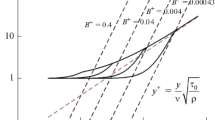Abstract
An explanation is given for a phenomenon observed e.g. in a wall jet in a small region near the maximum velocity. The turbulence shear stress is expressed as the sum of two terms, proportional to the first and the second derivative of the mean velocity, respectively. Use is made of the nonsymmetric flow pattern around the maximum velocity, and of the nonuniform distribution of the intensity of the lateral turbulence velocity component. The coefficient of the second derivative of the mean velocity is shown to contain the first derivative of this turbulence velocity component. Since the second derivative of the mean velocity is negative around its maximum, a positive turbulence intensity gradient as observed in the region concerned in the wall jet, results in a negative contribution to the shear stress. Hence, in this region the shear stress can have a sign opposite to the positive — though very small — gradient of the mean velocity. Consequences with respect to the mechanical energy balance of the mean flow and of the turbulence are discussed.
Similar content being viewed by others
Abbreviations
- P:
-
mean static pressure
- p :
-
turbulence static pressure
- t :
-
time
- Ū i :
-
mean velocity component in x i direction
- u i :
-
turbulence velocity component in x i direction
- u′ i :
-
root mean square value of u i
- u 2− :
-
negative value of u 2
- u 2+ :
-
positive value of u 2
- x i :
-
Cartesian coordinates, i=1, 2, 3
- x 2− :
-
negative value of distance x 2 to control plane
- x 2+ :
-
positive value of distance x 2 to control plane
- (x 2)1/2 :
-
half value distance
- α, β, γ :
-
numerical constants
- ε m :
-
eddy viscosity
- ν :
-
kinematic viscosity
- ρ :
-
density
References
Eskinazi, S. and H. Yeh, J. Aeron. Sci. 23 (1956) 23.
Margolis, S., An Investigation of a Curved Mixing Layer, report 3227-E, Dept. of Mech. Enging., Pennsylvania State Univ., University Park (Pa.) U.S.A. 1963.
Kruka, V. and S. Eskinazi, J. Fluid Mech. 20 (1964) 555.
Eskinazi, S., J. Mécanique 3 (1964) 313.
Beguier, C., Compt. Rend. 260 (1965) 5460.
Beguier, C., J. Mécanique 4 (1965) 319.
Tailland, A. and J. Mathieu, J. Mécanique 6 (1967) 103.
Townsend, A. A., Australian J. Sci. Res. 2 (1949) 451.
Hinze, J. O., Turbulence, p. 288, McGraw-Hill, New York 1959.
Author information
Authors and Affiliations
Rights and permissions
About this article
Cite this article
Hinze, J.O. Turbulent flow regions with shear stress and mean velocity gradient of opposite sign. Appl. Sci. Res. 22, 163–175 (1970). https://doi.org/10.1007/BF00400525
Received:
Revised:
Issue Date:
DOI: https://doi.org/10.1007/BF00400525



